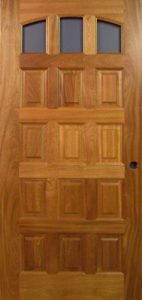Choosing and Caring for Your Hardwood Door
Here at Allegheny Wood Works, we have a large selection of door designs that are available in any of our eighteen different wood species. While an exterior door can be made from any specie of wood that we offer, not all species are created equal. When choosing a wood for your solid wood door, there are a number of factors to consider:
#1 Exposure.The amount of sunlight and weather the door is going to be subjected to. Wood comes from living material and is much more sensitive to the elements than fiberglass or metal. A solid wood door needs protection from the elements, including proper finishing and an adequate overhang. An excellent reference is provided in our door warranty.
#2 Wood Specie.When choosing a wood specie for your exterior door, it is important to remember that certain species of wood are simply better suited for an exterior application than others. Among the best species for exterior are White Oakand Mahogany, along with Cypress and Spanish Cedar. This is because these woods are naturally resistant to water, insects and decay. Also, these species have a much lower rate of expansion when exposed to moisture. Softer woods like alder, pine and poplar also have a low rate of expansion but are poor choices for exterior due to their lack of resistance to the elements. Conversely, species such as Ash and Hickory, while very hard and resistant, do not make good exterior species due to their enormous grain expansion when it is exposed to moisture. A detailed breakdown of preferred species will follow later in this article.
There are many materials used for exterior door construction, including metal, fiberglass, wood veneer, and solid hardwood. No matter what the door is crafted from, the majority of designs are trying to mimic the look of solid hardwood. Finely crafted wood doors add beauty and value to residential and commercial settings.
#3 Resistance to Decay.Decay is caused by the growth of fungus, which can be limited by choosing a wood that resists water. Tropical wood species as well as dense, heavy woods soak in water much slower than other woods.
 #4 Finishing. This is the key to the longevity of any solid wood product. There are two main finishing choices: prime and paint, or varnish (with or without stain). Paint is typically the most weather resistant finish option, but paint does not allow the natural grain and color to show. Stain and/or varnish shows off the woods natural characteristics and allows color to be added. Both need to be maintained on a regular basis. Depending on exposure, paint or varnish will need to be re-coated every 3-5 years. Doors that are well protected and receive little or no exposure may need less maintenance, while doors that see more exposure will need to be maintained more frequently. Proper finishing guidelines are also included in our door warranty.
#4 Finishing. This is the key to the longevity of any solid wood product. There are two main finishing choices: prime and paint, or varnish (with or without stain). Paint is typically the most weather resistant finish option, but paint does not allow the natural grain and color to show. Stain and/or varnish shows off the woods natural characteristics and allows color to be added. Both need to be maintained on a regular basis. Depending on exposure, paint or varnish will need to be re-coated every 3-5 years. Doors that are well protected and receive little or no exposure may need less maintenance, while doors that see more exposure will need to be maintained more frequently. Proper finishing guidelines are also included in our door warranty.
For exterior doors, Allegheny Wood Works recommends the following species, and we will break down their unique properties to assist in your choice.
Mahogany (African or Sapele)
Mahogany is red to brown in color with a fine grain texture and beautiful natural luster. Moderately resistant to rot, Mahogany also has excellent dimensional stability, meaning that it has only small expansion and contraction with changing humidity. Mahogany accepts stain well, and is also an excellent wood to paint.
White Oak
With a coarse, straight grain, and varying from pale yellow to medium brown, white oak has exceptional resistance to rot and decay. One of nature’s most durable and water resistant woods, white oak is frequently used not only in doors, but for boat construction, furniture, and whiskey barrels. This fine wood specie accepts stain well, but should not be painted. Paint tends to yellow and blister off of white oak, due to the natural makeup of this wood.
Cypress
With a distinct leafy grain, cypress varies from pale yellow to a yellowish red color. Some cypress will have naturally occurring pockets of darker wood. Although cypress is considerably softer than white oak and mahogany, its exceptionally high resistance to rot and decay make it a very good choice for exterior doors. Cypress produces an oil known as cypressene, which works as a natural preservative and provides resistance to insects. Cypress paints and stains well.
Spanish Cedar
Spanish cedar has a light pinkish brown to reddish brown color, tiny pin knots, gum pockets, and natural oils. It is very durable, and is light, naturally resistant to termites and decay. It also has a distinct, pleasant odor. While it is also softer than oak or mahogany, Spanish cedar weathers well, and easily accepts paints and stains.
A stunning solid hardwood door is an eye-catching addition to every home or business. With proper care, your door will last many, many years and be a memorable part of your home or business.
Reference materials can be found at:
https://solidhardwooddoors.com/HTML/door-woodspecies.html
https://solidhardwooddoors.com/HTML/warranty.html
https://solidhardwooddoors.com/HTML/door-exterior.html
http://www.wood-database.com
http://www.woodworkerssource.com


